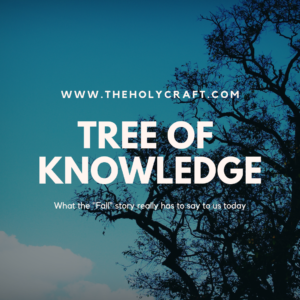What happened when Adam and Eve ate from the fruit of the Tree of Knowledge of Good and Evil?
If you’ve made it this far in the series, The Work of Creation, you understand that here at The Holy Craft, we take the creation stories seriously but not literally. We read these stories as creation myths, telling us deeply held truths about our traditions, the human condition, and our identities. However, we don’t hold them as exact histories of what happened.
Whether Adam and Eve really ate the fruit does not matter.
What is most interesting to us is how it has been interpreted over the years. Pages and pages of ink and even some blood has been spilled over expressing what was going on in the story after the Two ate the fruit of the Tree of Knowledge of Good and Evil. It is fair to say that this text has been the resource for many fiery sermons that have tried to convince people they are destined for hell.
This text, dubbed “The Fall” or “The Fall of Man” is the primary fuel for the fires that consume sinners for eternity. (Side note: It is always funny to see exclusive language for humanity bite people in the ass when they call it the Fall of Man; sure, men are the only ones to fall). This text is the resource for the idea of Original Sin.

Original sin is the idea that Adam and Eve’s act of defiance and disobedience is either literally or figuratively passed down through every generation as a type of curse that separates humanity from God. Remember, these stories were written while the Hebrew people were in exile. They’d endured some horrible treatment, so they were trying to make sense of why they inherited such problems. It may have been written with good intentions, but it’s been the interpreters that have messed things up for the rest of us, once again.
Harvey Cox says, “Like many other doctrinal formulations that have arisen over the past centuries, the doctrine of original sin may once have helped clarify our human situation, but unfortunately it also produced some negative byproducts.”
We expected too much out of the story. Danielle Shroyer, in her book Original Blessing, writes “If the story of Jesus took four gospels and hundreds of chapters to tell, then it is presumptuous to expect one chapter in Genesis to tell you everything you need to know about death, sin, human nature, immortality, the laws of the universe, and humankind’s struggle. Consider the possibility that while Genesis 3 is a great text to spark questions, it isn’t trying to answer a good number of those questions. It is not trying to determine how sin entered the world, or where death came from, or why people sin. Genesis 3 is not a laboratory experiment where we get conclusive results about some shocking alteration to our human DNA. If we have sane and simple expectations for the story, we will be much more equipped to read what it says, rather than what we think it means.”
One of the major issues is that this story of original sin has been used to manipulate people and shame people. The old preacher shouts, “You are sinners bound for hell!” Or the young preacher in a slightly tighter t-shirt says, “You have turned your back on God and so God has turned His* back on you.” (*Gendered language for God only because young white male preachers in tight t-shirts imagine God like themselves, by and large).
The story of the fall has been used to support Calvinists’ horrid belief in Total Depravity: the idea that we are wholly bad and incapable of creating anything good apart from God.
When has it ever been good or useful to continue to remind people about how bad they are? And how did that ever get turned into Good News?
And why did we ever become satisfied with a world that blames all of the wrongs, the suffering, the evil and hurt on some obscure religious concept called sin? We’ve taken the interpretive easy road here—just blame everything you can’t explain on sin. None of this is good news. None of it promotes holistic faith.
So can we mine this story for meaning? There are many who see the story of Adam and Eve partaking from the fruit of the Tree of Knowledge of Good and Evil as a coming of age story. What if eating the fruit is a metaphor for Adam and Eve’s maturation? What if they teach us a lesson about development and opening our own eyes? Adam and Eve’s eyes are opened to a loss of innocence.
Do you remember the first time you saw someone do something bad? Or the first time you saw someone suffering? You lost a little bit of innocence that day. This story was written in communities of people who had just gotten pillaged and decimated. There’s no telling what some of those people saw for the first time. They were then sent off into enemy land to live, where they were probably uncomfortable seeing new things that they could have never imagined. Their eyes were opened.
They are representative of us. Adam and Eve are every person as we mature and lose our innocence. And it is good, because losing our innocence allows us to see the hurt and offer hope. It allows us to see the pain and offer compassion. The fall isn’t about some theological concept, but rather it’s about all of us. It’s about our eyes opening to the hurt and suffering in our world so that we can do something about it.
So the question is rather: are your eyes open? What are you doing about what you see? Are you hiding from it like Adam and Eve or are you leaning in to the discomfort and calling of what you now see?
1 thought on “Tree of Knowledge”
Comments are closed.